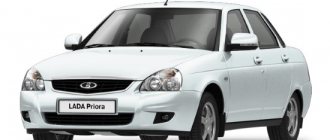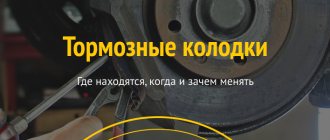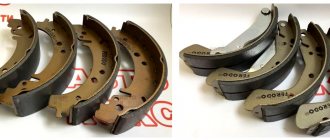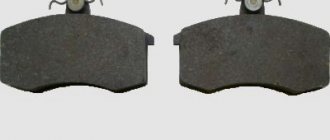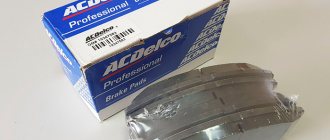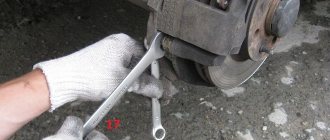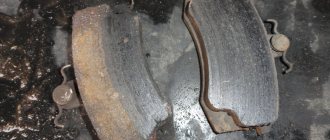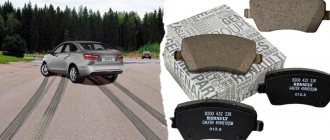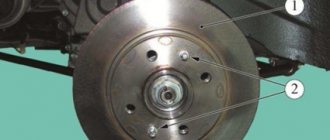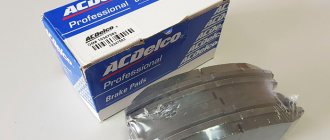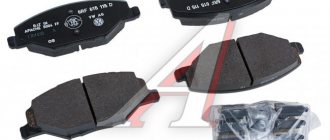In order for the brake system to always be normal, it is necessary to constantly monitor its components. Since brake pads work exclusively on friction, they wear out faster than other parts. It is impossible to say exactly when wear will occur; their conventional operational life is from 8 to 15 thousand kilometers during normal driving without “recklessness”. Checking the brake pads gives you an idea of when to replace them.
Brake system
Each vehicle is equipped with:
- braking mechanism;
- parking brake;
- spare brake . Used in emergency cases, when the main brakes fail. In passenger cars, this is usually achieved by dividing the brake system into several circuits diagonally or front/rear.
The brake system consists of a drive and a braking mechanism with a drum or disc, as well as brake pads. Drum brakes are now used less frequently, although they last longer. Today, almost all cars have a disc brake; such a system is considered fixed and has a caliper and two pads that are stable in one position. When the brake pedal is pressed, they compress the disc. There are also systems with a floating block; they are more complex. During braking, the caliper piston touches one of them, it moves away, leans against the disc and moves it towards the other, after which clamping occurs.
The main reasons affecting the wear rate
A brake pad has two components: a frame and a friction lining. In short, it is the pad that performs the main task of braking, stopping the brake disc with its friction. Front brake pads wear out two to three times faster than the rear ones. This is because a large load during braking falls on the front wheel mechanism, and the weight of the car is redistributed to the front axle. The wear rate is directly affected by:
- the material from which the parts are made. Each manufacturer sets its own thickness for the product, so you don’t need to look at the price and purchase original linings;
- weight vehicle;
Pads - sudden changes in air temperature;
- driving conditions . Sharp accelerations and emergency braking certainly shorten the life of products;
- brake assembly design . If there is a failure in the cylinders, this will also affect the pads.
It is noteworthy that in the winter season, replacement is performed less frequently, which suggests that in winter there are few maneuvers while driving.
Why do pads wear out?
First of all, it is necessary to consider why the part becomes unusable.
The thing is that the pads are equipped with a special friction lining, which during operation is constantly in contact with the disc. All this leads to abrasion.
The rate of wear can vary and depends on several factors, including the metal of manufacture and driving style.
Signs of wear
Sometimes, just to assess the condition of the linings, it is not at all necessary to get into the brake system. Many people are interested in how to check brake pads without removing the wheel? Wear can be determined by the following signs:
- When emergency braking occurs, a specific sound occurs in the wheel. This indicates that uneven wear of parts has occurred. Their plates are worn out and touch the brake discs, creating a squeak. A similar noise is accompanied by disk wear.
- Pad wear sensor. Almost all modern cars have indicators showing the condition of the mechanism. The sensor looks like a lamp; when it lights up, it means it’s time to change the pads. Sometimes oxidation of the contacts occurs, and the indicator may simply not work, then wear will have to be determined visually.
- The system began to behave strangely when the speed decreased. The brake fluid level decreases, and the pedal is pressed softly, slightly pressing down, or, conversely, when pressed, a lock is activated.
Brake pad replacement process - If you find metal shavings on the discs, you need to go to a service station, since not only the pads have worn out, but also the disc has worn out.
- Long braking distance.
Diagnostics of the brake system. Methods for eliminating vibration and noise
The longer a car is used, the more problems the car owner encounters due to failed components and parts.
In such cases, you should not hesitate and try to immediately find the cause of the troubles that have arisen, especially if it concerns the brake system of the car. If you do not pay attention to the vibration and beating of brake discs in time, you can be left without a car in the literal sense of the word, putting not only your life in serious danger, but also other road users. Severe vibration and beating are a consequence of incorrect wheel balancing or premature wear of tire material, failure of car suspension elements or the working surface of the brake system discs. Therefore, it is recommended to periodically check the brake discs to avoid troubles.
Crooked brake discs symptoms
PS I honestly searched but didn’t find anything like that. There is nothing rattling in the suspension, the silent blocks are almost new. The disc pads are not left-handed for sure. No violence was done to the car, my guesses - the hub - crappy tires, becoming the best imported ones, Michelin there (never skimp on tires!!) - crappy brake pads, install the original
Well, our tires are only imported, I just have new Michelin. what about the hub?? and how to explain that after the replacement everything was ok
hub curve mb. the disk and hub seats will come from the forum people in the morning, they will say something else very useful
PS. If brake pads are cheap, it’s 90% because of them.
Volkswagens really don’t like it when they put all sorts of guano on them instead of spare parts standards, I already understood this myself. The miser pays twice
Brambo wheels, Textar pads, both of them are pretty decent brands. When the discs were installed, the hub was sanded.
It was similar, I even signed up for disc sharpening. When they lifted the car, it turned out that I had caught a construction bolt in the rear wheel (AND THEY WERE CHECKING THE FRONT ALL THE TIME). It is unlikely that your option. Wheel balancing was checked several times in different services, everything is ok. but expressed it as an option. Thank you for your attention.
Added after 1 minute 52 seconds:
Brambo wheels, Textar pads, both of them are pretty decent brands. When the discs were installed, the hub was sanded. The same thing stands, and the hubs were also sanded. Only Dunlop tires in summer.
The brakes on your car are designed to help you travel safely on the road. Their serviceability is the key to avoiding emergency operation of the device, preserving the lives of drivers, passengers and pedestrians.
When buying a used car, you need to know the main signs of wear on the brake system in order to protect yourself and others from unforeseen situations.
What you need to visually pay attention to to determine brake disc wear
The main sign of wear on the brake system is indicated by pulsation of the brake pedal and vibration of the car, as well as its body.
The serviceability of the rear brake can be checked in this way: put the car in reverse and press the brake pedal. If the car is reluctant to stop, this indicates a problem with the rear brake system.
The listed signs are indirect, visual. The main malfunctions of the disks are revealed by direct inspection and measurement of wear.
When checking the discs, you can detect deformation or misalignment of the part, the presence of deep chips, scratches, a protruding edge along the edge, reduced thickness, or cracking. All this indicates disk wear and requires replacement.
What to look for when removing a wheel to determine brake disc wear
When buying a new car, you need to check the brake system using the methods described in order to have an idea of its condition and make the right decision. In order to avoid troubles in the further operation of the vehicle.
The longer a car is used, the more problems the car owner encounters due to failed components and parts. In such cases, you should not hesitate and try to immediately find the cause of the troubles that have arisen, especially if it concerns the brake system of the car. If you do not pay attention to the vibration and beating of brake discs in time, you can be left without a car in the literal sense of the word, putting not only your life in serious danger, but also other road users.
Severe vibration and beating are a consequence of incorrect wheel balancing or premature wear of tire material, failure of car suspension elements or the working surface of the brake system discs. Therefore, it is recommended to periodically check the brake discs to avoid troubles.
Checking the pads without removing the wheel
Checking brake pad wear is not difficult, especially when the vehicle has alloy wheels with large holes through which the brake assembly is visible. As a rule, only the outer block is visible. If you determine its thickness visually, then 1.5–2 millimeters is considered critical. When, even without removing the wheels, you notice that the thickness of the lining is less than 5 millimeters, this is a reason for replacement. If the holes on the wheel are too small and the brake mechanism is hard to see, you need to start dismantling the wheel. When nothing interferes with the view, it is easy to assess the condition of the second lining and, at the same time, the brake disc.
When to change pads
If a motorist’s knowledge of the operation of the brake system is complete darkness, then it is better to trust a professional to replace consumables in it. Typically, pads are changed when the material has already worn down to a critical value (at the same time, characteristic sounds of alarms are heard or the wear sensor on the instrument panel is triggered). The second case is scheduled vehicle maintenance.
Most motorists perform this procedure in the first case. If the car travels a short distance throughout the year, it would be better to carry out diagnostics of the entire vehicle at least once a year, which will involve various manipulations, including checking the condition of the pads.
In the case of high mileage with measured “retirement” driving, the pads may still look good even after 50 thousand. It is still recommended to replace such elements, since over time, due to their strong heating and cooling, the material becomes coarser. Because of this, during the braking process, it is not the friction lining that can wear out, but the disc or drum itself.
Permissible pad wear
Typically, the standard by which the permissible wear of friction material is determined is universal for all cars. The minimum thickness of the lining should be between three and two millimeters. At this stage they need to be changed. Moreover, when diagnosing, you should pay attention to the thinnest part of the block if uneven wear is observed on it. Of course, in this case it is necessary to eliminate the reason why the pad does not completely adhere to the surface of the disc.
It is worth noting that as the tonnage of the vehicle increases, the minimum thickness of the pads should be greater. As for SUVs or crossovers, this parameter should be 3.5-3.0 millimeters. For small cars and passenger cars, the acceptable thickness is considered to be up to two mm.
Regardless of whether the pads have become unusable or not, for the sake of safety on the road, we still recommend double-checking to what extent they have worn out. The seasonal tire change procedure is ideal for this.
Proper Pad and Disc Inspection Process
Before checking, review the table of permissible dimensions of brake parts. When the data matches, start making replacements. The process is divided into the following stages:
- We place the vehicle on a jack and remove the front wheel.
- We clean the disk from settled dust.
- Using a caliper we determine the thickness of the disc. The permissible wear parameter is 10.8 mm.
- In the inspection window we determine the thickness of both pads; you can take a caliper.
- Use a screwdriver to see how the pads move. When they move tightly, it means they have compressed the disc. If the wear is uneven, a new cylinder and caliper must be installed.
- To get to the rear ones, remove the wheel and drum.
- We measure their thickness and the size of the drum surface. The diameter should not exceed 201.5 mm.
Brake pads
Parts need to be replaced if:
- linings in oil;
- products thinner than 1.5 mm;
- the linings are not tightly connected to the base;
- Discs need to be replaced if there are scratches or deformation.
About the main types of pads
The auto industry has come a long way in the near future. A modern car, you have an advanced braking system, is the presence of computer-controlled systems. This should include Abs, directional stability system, etc. The constant development of cars leads to progress in the types of brake pads. The following types are distinguished:
- with a semi-metallic friction layer (65% copper, iron powder, wire);
- organic friction layer (rubber, glass, Kevlar);
- from organic matter and iron inclusions in a ratio of 70/30);
- clay friction layer with a small inclusion of copper.
Which of the above types has its own strengths and weaknesses. For example, a semi-metallic friction layer has good heat dissipation, but it wears out quickly and makes a lot of noise during operation. But organic brake pad linings actually do not create noise and work smoothly, but during the process they emit a lot of dust that settles on the wheel disk. It is safe to see that pottery is more desirable. They do not create noise and do not wear out very quickly. Their only drawback. highest price.
KEY-DOP
Replacing front brake pads
- We secure the car with the handbrake and place barriers under the wheels. All you need are keys No. 13 and 17, as well as a screwdriver.
- We dismantle the wheel and check the brake fluid level at the same time. It should be between the MIN and MAX marks on the tank body.
- We press on the piston and pull the caliper until it stops.
- Use a wrench No. 13 to remove the lower bolt, and use a wrench No. 17 to hold the guide pin at this moment. We lift the body and take out the pads. We remove dirt, if any.
- We install new products, the springs are installed parallel to the top of the pads. We move the bracket body down and fasten the bolt in place, after which we bend the tendril of the lock washer.
- Install the wheel. Next, you need to press the brake several times to check the piston.
Worn brake pad
How to determine brake disc wear
Checking the wear of brake discs is not quite difficult; the main thing is to have a caliper or micrometer on hand, and if you don’t have such tools, then, as a last resort, you can use a ruler or a coin (more on this below). The thickness of the disc is measured at 5...8 points around the circle, and if it changes, it means that in addition to wear on the braking area, there is curvature or uneven abrasion. Therefore, it will be necessary not only to change it at the limit, but also to find out the reason due to which uneven wear of the brake disc occurs.
How is it checked?
In order to find out the degree of wear, it is best to dismantle the wheel, since the thickness of the disk cannot be measured otherwise, and if you need to check the wear of the rear brake drums, you will have to completely remove the entire brake mechanism. When carrying out further inspection, it is necessary to take into account that the discs wear out on both sides - external and internal. And not always evenly, so you need to find out the degree of wear of the disk on both sides of the disk, but more on that below.
Before checking, you definitely need to know information about the thickness of the new brake disc for a particular car. You can find it in the technical documentation or on the disk itself.
Brake disc wear limit
The value of the maximum permissible wear will depend on the initial size of the disc and the power of the car engine. Typically, the total wear of the entire disc for passenger cars is about 3...4 mm. And for specific planes (internal and external) about 1.5...2 mm. With such wear and tear, they need to be replaced. For brake discs consisting of one plane (usually installed on rear brakes), the procedure will be similar.
Checking the wear of brake discs involves checking the thickness of both planes of the disc, the size of the flange, and then comparing this data with the nominal value that a new disc should have, or recommended parameters. Also evaluate the general nature of abrasion of the working area of the disk, namely, uniformity, the presence of grooves and cracks (the size of cracks should not be more than 0.01 mm).
During a routine inspection, it is necessary to look at the size of the excavation grooves and their structure. Small regular grooves are normal wear. It is recommended to replace discs paired with pads if there are deep irregular grooves. If the brake disc wears conically, it is necessary to change it and check the brake caliper. If the disc shows cracks or other corrosion and discoloration, it is usually due to thermal phenomena resulting from frequent and excessive changes in the temperature of the disc. They cause noise when braking and reduce braking efficiency. Therefore, it is also advisable to replace the disk and install better ones with improved heat dissipation.
